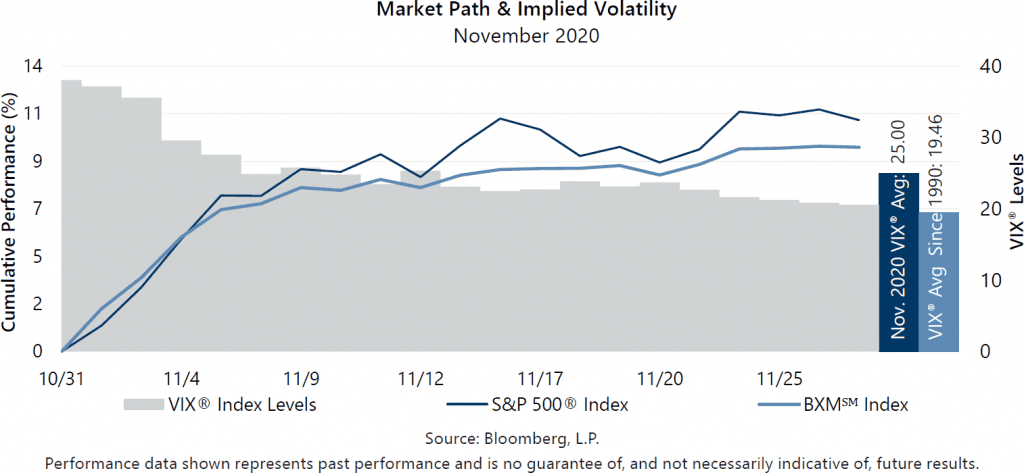The S&P 500® Index returned 10.95% for the month of November, bringing its year-to-date return to 14.02%. As election uncertainty faded and progress was made on COVID-19 vaccines, losses from September and October were recovered and the equity market delivered its second highest total return of any November on record while also reaching a new all-time high price. From its previous high on September 2 through November 30, the S&P 500® Index returned 1.54%.
Macroeconomic data continued to reflect an ongoing recovery from the negative effects of COVID-19 mitigation efforts. The second estimate of Gross Domestic Product for the third quarter of 2020 showed that the U.S. grew at an annualized rate of 33.1%, in line with consensus expectations. The unemployment rate improved from 7.9% in September to 6.9% in October, beating consensus expectations, while the participation rate climbed to 61.7%. The October Consumer Price Index, released on November 12, showed a 1.2% year-over-year increase, slightly below consensus estimates. With over 96% of companies reporting, third quarter aggregate operating earnings were on track to decline 1.52% quarter-over-quarter and 19.34% year-over-year. More than 86% of the companies that have reported earnings met or exceeded analyst estimates.
Implied volatility, as measured by the Cboe® Volatility Index (the VIX®), averaged 25.00 in November 2020. Consistent with its normal relationship, average implied volatility exceeded realized volatility, as measured by the standard deviation of daily returns for the S&P 500® Index, which was 16.06% for the month. The spread between the two statistics was more than double the historical monthly average. The VIX® opened the month at an intra-month high of 37.13. As the election uncertainty faded and the equity market rallied, the VIX® drifted to close November at an intra-month low of 20.57. The VIX® remained above its historical average of 19.46 throughout the month.

The Cboe® S&P 500 BuyWriteSM Index1 (the BXMSM) returned 9.66% in November, underperforming the S&P 500® Index by 129 basis points (bps) and bringing its year-to-date return to -4.45%. On the third Friday of each month, the BXMSM writes a new index call option as the option it wrote the previous month expires. The premiums the BXMSM collects on its written index call options have significant influence on its return potential during market advances and help to mitigate market declines. The equity market’s decline between October 16 through October 30 brought the price of the S&P 500® Index well-below the strike price of the BXM’sSM written index call option. With its written index call option significantly out-of the money as November began, the BXMSM was well-positioned for participation in the market rally. From November 1 through November 20, the BXMSM returned 8.34%, nearly keeping pace with the 8.94% return of the S&P 500® Index over the same time period. On November 20, the BXMSM wrote a new index call option with a December expiration and collected a premium of 1.93% as a percentage of the BXM’sSM underlying value. From November 20 through month end, the BXMSM returned 1.21%, slightly trailing the 1.84% return of the S&P 500® Index.
The Bloomberg Barclays U.S. Aggregate Bond Index returned 0.98% in November, bringing its year-to-date return to 7.36%. The yield on the 10-year U.S. Treasury Note (the 10-year) started November at 0.84% before dropping to an intra-month low of 0.76% early in the month. The yield on the 10-year reached an intra-month high of 0.98% on November 11, before drifting lower to end the month at 0.84%.
1The BXMSM is a passive total return index designed to track the performance of a hypothetical buy-write strategy on the S&P 500® Index. The construction methodology of the index includes buying an equity portfolio replicating the holdings of the S&P 500® Index and selling a single one-month S&P 500® Index call option with a strike price approximately at-the-money each month on the Friday of the standard index-option expiration cycle and holding that position until the next expiration.


